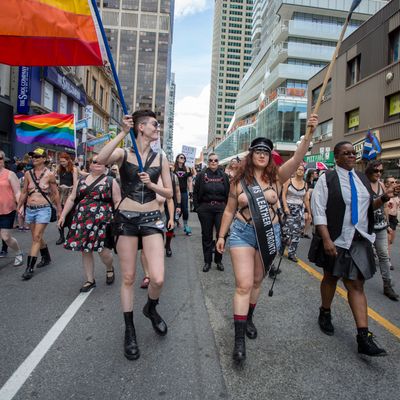
Almost a year after I moved to New York, I was still wrestling with where exactly I fit into the LGBTQ community. So, despite the fact that my only queer friend was out of town, come Pride weekend I decided to go to the parade alone. As I watched the crowd of thousands march down 8th Street, something inside me snapped into place. I waved and cheered, the anonymity allowing me to embrace an identity I’d skirted for years. At the time, the atmosphere of celebration was just what I needed. But this year, my friends and I are doing something different: We’re headed to Bryant Park for the Dyke March.
Like the Pride March, the Dyke March was started by activists — in this case the Lesbian Avengers — more than a decade ago. The first march took place in Washington, D.C., in 1993, when 20,000 self-identified dykes took to the streets without a permit in conjunction with the March on Washington. The event inspired organizers in New York to hold their own march, and it’s continued every year since. Last year, organizers Maxine Wolfe and Alex Tereshonkova estimate 10,000 people participated. And this year’s crowd could be even bigger as people (like my friends and me) choose to attend it in lieu of a Pride March we feel no longer represents us.
Back in 2015, I found the solidarity I needed at the Pride March, but even then it had morphed into something that barely resembled its protest origins. The parade boasted sponsorships from companies like Lyft, TD Bank, and Metlife Insurance. Last year Walmart and T-Mobile were top contributors to the march’s $1.7 million in sponsorships, and this year’s “platinum” sponsors include Delta, Vitamin Water, and Diet Coke. And although Heritage of Pride — the group that organizes New York City’s annual celebration — generates millions in revenue, it still asks local LGBTQ musicians to perform free of charge. This year, you can watch the whole thing on live TV like the Macy’s Thanksgiving Day Parade. The movement that began as a pointed rebuttal to discrimination feels as though it’s lost its fangs.
The commodification of queerness didn’t bother me the first time I attended the march. I wore a rainbow TD Bank lanyard around my neck and cheered the Netflix float carrying half the cast of Orange is the New Black. But after three years of sinking deeper into New York’s LGBTQ community, I share the discomfort I hear echoed in many of my groups of friends: that the Pride March is just good PR for the companies and politicians who participate in it; that it sidelines trans women and people of color; that its air of celebration isn’t in line with the reality of LGBTQ existence even in the city, where in the past month two transgender women were beaten and slashed in Brooklyn while walking back from a gay bar, and a lesbian couple was viciously attacked on the Q train. Right now, with LGBTQ rights under threat, I want to remind those in power that we can’t be placated.
For me, the Dyke March is an alternative that hews much closer to the original Pride March, a “protest rally” organized in response to the Stonewall Riots, and which Michael Brown, a founder of the Gay Liberation Front, justified like this: “We have to come out into the open and stop being ashamed, or else people will go on treating us as freaks.” The Dyke March still operates on donations and fundraisers — it has no corporate sponsors, no permits, no police protection. “It’s a protest march; it’s not a parade,” Wolfe says. “We started out as a protest, and we stayed that way because, until everyone in our communities is free, what’s the point?” There are no floats at the Dyke March, and if celebrities show up, they blend into the crowd. No one is shelling out thousands to LeAnn Rimes, and Mayor de Blasio probably won’t make an appearance. Instead, marchers carry homemade picket signs and shout chants. When I asked a friend for outfit advice, she said, “Less rainbow shit, more leather.”
Wolfe says that the attitude of marchers changes from year to year; last year’s march was “heavy,” with the Orlando shooting fresh in everyone’s minds. But this year, thanks to the current administration’s attitude toward LGBTQ rights, she’s expecting an uptick in protest energy — a renewed sense of outrage.
As much as she’s against the Pride March’s “corporate sponsorship and authoritarian rules,” however, Wolfe is careful not to position the Dyke March as its foe. “The Sunday march is not the devil,” she said. “The enemies wear suits; they don’t walk around nude. The enemies are taking away our rights; they’re not dancing to disco. And if I’m going to put energy into fighting our enemies, those are the people I’m going to fight.”
“The Dyke March provides an alternative,” she added. “But an alternative doesn’t mean you have to shut something else down.”
As a nervous 20-something dipping her toe into the queer community, the Pride March felt right to me. But this year, I’d rather protest than parade.

